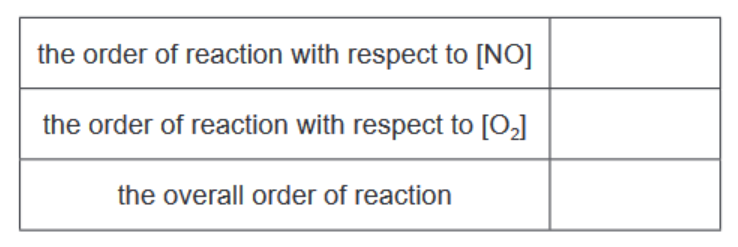Question
Nitrogen monoxide, $\mathrm{NO}$, reacts with oxygen to form nitrogen dioxide, $\mathrm{NO}_2$.
$
2 \mathrm{NO}(\mathrm{g})+\mathrm{O}_2(\mathrm{~g}) \rightleftharpoons 2 \mathrm{NO}_2(\mathrm{~g})
$
The rate equation for the forward reaction is shown.
$
\text { rate }=k[\mathrm{NO}]^2\left[\mathrm{O}_2\right]
$
(a) Complete the following table.

(b) Two separate experiments are carried out at $30^{\circ} \mathrm{C}$ to determine the rate of the forward reaction.

(i) Use the data for experiment 1 to calculate the value of the rate constant, k. State the units of k.
$k=$ units $=$[2]
(ii) Calculate the value of $[\mathrm{NO}]$ in experiment 2.
$ [\mathrm{NO}]= $ $\mathrm{moldm}^{-3}$ [1]
(c) Define the term rate-determining step. [1]
(d) Peroxodisulfate ions, $\mathrm{S}_2 \mathrm{O}_8{ }^{2-}$, react with iodide ions, $\mathrm{I}^{-}$.
$
\mathrm{S}_2 \mathrm{O}_8{ }^{2-}+2 \mathrm{I}^{-} \rightarrow 2 \mathrm{SO}_4{ }^{2-}+\mathrm{I}_2
$
The rate equation for the reaction in the absence of any catalyst is shown.
$
\text { rate }=k\left[\mathrm{~S}_2 \mathrm{O}_8{ }^{2-}\right]\left[\mathrm{I}^{-}\right]
$
(i) Suggest equations for a two-step mechanism for this reaction, stating which of the two steps is the rate-determining step.
step 1…………………………………….
step 2…………………………………..
rate-determining step $=$ [5]
(ii) A large excess of peroxodisulfate ions is mixed with iodide ions. Immediately after mixing, $\left[I^{-}\right]=0.00780 \mathrm{moldm}^{-3}$. Under the conditions used, the half-life of $\left[I^{-}\right]$is 48 seconds.
Calculate the iodide ion concentration 192 seconds after the peroxodisulfate and iodide ions are mixed.
iodide ion concentration $=$ $\mathrm{moldm}^{-3}[1]$ [Total: 8]
▶️Answer/Explanation
Ans:
(a)

ALL CORRECT [1]
(b)(i) $\begin{aligned} & k=\left(1.51 \times 10^{-4}\right) /\left(0.003^2 \times 0.00200\right) \\ & k=8389[1] \min 2 \mathrm{sf}\end{aligned}$
$\mathrm{mol}^{-2} \mathrm{dm}^6 \mathrm{~s}^{-1}[1]$
(b)(ii) $\begin{aligned} & 8400=\left(6.05 \times 10^{-5}\right) /\left(x^2 \times 0.005\right) \\ & x=\sqrt{ }\left(6.05 \times 10^{-5}\right) /(8400 \times 0.005) \\ & x=0.00120 / 1.20 \times 10^{-3}[1] \min 2 \text { sf ecf from Q1bi }\end{aligned}$
1(c) slow(est) [1]
(d)(i) correct RDS identified as step 1 with only one $\mathbf{S}_2 \mathbf{O}_8{ }^{2-}$ and one $\mathbf{I}^{-}[1]$
overall mechanism adds up to chemical equation and no cancellable species on LHS/RHS in each of the equations [1] M2 DEP on one $\mathrm{S}_2 \mathrm{O}_8{ }^{2-}$ and one $\mathrm{I}^{-}$in step 1
e.g. step $1 \mathrm{~S}_2 \mathrm{O}_8{ }^{2-}+\mathrm{I}^{-} \rightarrow \mathrm{SO}_4{ }^{2-}+\mathrm{SO}_4 \mathrm{I}^{-} \quad \mathrm{RDS}=$ step 1 step $2 \mathrm{SO}_4 \mathrm{I}^{-}+\mathrm{I}^{-} \rightarrow \mathrm{SO}_4{ }^{2-}+\mathrm{I}_2$
(d)(ii) no. of $t_{1 / 2}=192 / 48=4$
$\left[I^{-}\right]=0.0078 / 16=4.9 \times 10^{-4}[1] \min 2 s f$
Question
(a) Manganese(IV) oxide, $\mathrm{MnO}_2$, catalyses the decomposition of hydrogen peroxide, $\mathrm{H}_2 \mathrm{O}_2$, as shown.
$
2 \mathrm{H}_2 \mathrm{O}_2(\mathrm{aq}) \stackrel{\mathrm{MnO}_2}{\longrightarrow} 2 \mathrm{H}_2 \mathrm{O}(\mathrm{l})+\mathrm{O}_2(\mathrm{~g})
$
The mechanism involves the formation of the intermediate species, $\mathrm{Mn}^{2+}$, in the first step which is subsequently used up in the second step.
State and use relevant electrode potentials, $E^{\ominus}$, to construct two equations to show how $\mathrm{MnO}_2$ can catalyse this reaction.
equation 1 ………………………………………………………………………………………………………………….
equation 2 …………………………………………………………………………………………………………………. [3]
(b) The equation for the decomposition of hydrogen peroxide without a catalyst is shown.
$
2 \mathrm{H}_2 \mathrm{O}_2(\mathrm{aq}) \rightarrow 2 \mathrm{H}_2 \mathrm{O}(\mathrm{I})+\mathrm{O}_2(\mathrm{~g})
$
Under certain conditions this reaction is found to be first order with respect to hydrogen peroxide, with a rate constant, $k$, of $2.0 \times 10^{-6} \mathrm{~s}^{-1}$ at $298 \mathrm{~K}$.
Calculate the initial rate of decomposition of a $0.75 \mathrm{~mol} \mathrm{dm}^{-3}$ hydrogen peroxide solution at $298 \mathrm{~K}$.
initial rate $=$ $\mathrm{moldm}^{-3} \mathrm{~s}^{-1}$ [1]
(c) A four-step mechanism is suggested for the reaction between hydrogen peroxide and iodide ions in an acidic solution.
step $1 \mathrm{H}_2 \mathrm{O}_2+\mathrm{I}^{-} \rightarrow \mathrm{IO}^{-}+\mathrm{H}_2 \mathrm{O}$
step $2 \mathrm{H}^{+}+\mathrm{IO}^{-} \rightarrow \mathrm{HIO}$
step $3 \mathrm{HIO}+\mathrm{I}^{-} \rightarrow \mathrm{I}_2+\mathrm{OH}^{-}$
step $4 \mathrm{OH}^{-}+\mathrm{H}^{+} \rightarrow \mathrm{H}_2 \mathrm{O}$
Step 1 is the rate-determining step.
(i) State what is meant by the term rate-determining step. [1]
(ii) Use this mechanism to construct a balanced equation for this reaction. [1]
(iii) Deduce the order of reaction with respect to each of the following.
$\mathrm{H}_2 \mathrm{O}_2=$
$\mathrm{I}^{-}=$
$\mathrm{H}^{+}=$ [1] [Total: 7]
▶️Answer/Explanation
Ans:
M1 data seen $\mathrm{H}_2 \mathrm{O}_2 / \mathrm{H}_2 \mathrm{O}+1.77 \mathrm{~V}$ and $\mathrm{MnO}_2 / \mathrm{Mn}^{2+}+1.23 \mathrm{~V}$ and $\mathrm{O}_2 / \mathrm{H}_2 \mathrm{O}_2+0.68 \mathrm{~V}$ OR $E_{\text {cell }}=0.55 \mathrm{~V}$ (first step) and $0.54 \mathrm{~V}$ (second step)
M2 $\mathrm{MnO}_2+\mathrm{H}_2 \mathrm{O}_2+2 \mathrm{H}^{+} \rightarrow \mathrm{Mn}^{2+}+\mathrm{O}_2+2 \mathrm{H}_2 \mathrm{O}$
$\mathrm{M} 3 \mathrm{Mn}^{2+}+\mathrm{H}_2 \mathrm{O}_2 \rightarrow \mathrm{MnO}_2+2 \mathrm{H}^{+}$
$9(b) \quad$ rate $=2.0 \times 10^{-6} \times 0.75=1.5 \times 10^{-6}$
c)(i) slowest step in overall reaction
(c)(ii) $\begin{aligned} & \mathrm{H}_2 \mathrm{O}_2+2 \mathrm{H}^{+}+2 \mathrm{I}^{-} \rightarrow \mathrm{I}_2+2 \mathrm{H}_2 \mathrm{O} \\ & \text { OR } \mathrm{H}_2 \mathrm{O}_2+2 \mathrm{HI} \rightarrow \mathrm{I}_2+2 \mathrm{H}_2 \mathrm{O}\end{aligned}$
9(c)(iii) $\mathrm{H}_2 \mathrm{O}_2=1$ AND I- $=1$ AND $\mathrm{H}^{+}=0$